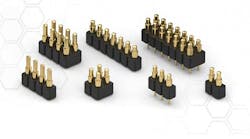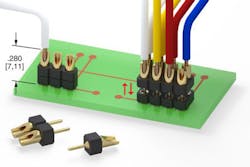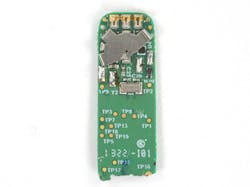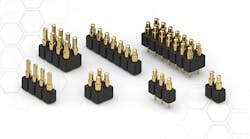Does it suprise you that the global connector market is expected to reach an estimated $80.4B by 2023? That’s the number cited in a report released in January by Report Linker. Given that every electronic device relies on connectors of some sort, it’s clear that connectors are big business.
Mill-Max low-profile solder cup headers. (Credit: Mill-Max)
Helping to spur demand is the miniaturization of the technology, in response to the rise of the Internet of Things (IoT), along with the Maker movement and open-source hardware. Always at a premium, the space to accommodate connectors is becoming ever-smaller and manufacturers continue to produce tinier and more unique connectors based on these increasingly demanding requirements.
We now have smartphones that measure only a few millimeters in width, yet pack in more power and functionality than a top-tier gaming desktop from a decade ago. Still, they require a set of reliable connections to work. Simillarly, single-board computers (SBCs) such as the popular Raspberry Pi and Arduino boards are serving as the platform to make everything from home arcade systems to technologies for the smart home. Several different connectors, including GPIO pins, micro USB, HDMI, and camera connectors, are required, all on these single, tiny PCBs.
The miniaturization of technology has also led to the development of wearable technology and IoT platforms for all different types of applications. Just as the name sounds, wearable technology or “wearables” are devices worn on the body (or even implanted), such as fitness trackers, smartwatches, and mobile medical devices. All feature micro-hardware that require micro connectors to keep running smoothly.
Fitbit Flex STMicroelectronics mainboard with three gold-plated interconnects on the top. (Credit: iFixit)
To illustrate how small connectors now need to be, consider the Fitbit tracker. Inside a tiny polymer housing smaller than a half-dollar is a 31.7- × 8.9- × 6.8-mm STMicroelectronics 32L151C6 mainboard outfitted with a 3-axis accelerometer, LED display (simple dot), Bluetooth LE module, vibration motor, NFC antenna, and battery.
The mainboard offers a significant level of flex (for obvious reasons) and is connected to a USB dongle. Its three millimeter-sized, gold-plated interconnects can bend along with the board without compromising integrity.
Whether the application is smart glasses, watches, portable health monitors, smart clothing, or skin patches, flexible micro-connectors exist that are up to the task of maintaining performance while under stress. Wearables can take advantage of micro USB, board-to-board, card, board-to-flexible printed circuit, battery, and custom cable connectors (to name a few).
When it comes to space constraints, flexible printed circuitry (FPC) and FPC conductor/chip assembly (FPCA) connectors offer the most advantage for wearables and other small mobile devices. They can scale down to very low profiles with terminal pitches, ranging from 1.25 mm down to 0.35 mm and below. By no means does that smaller size equal decreased functionality—they still offer EMI shielding, ground terminals, impedance matching (between PCB and connector), and come in a variety of shell sizes and shapes. The power of FPCs is that they can be shaped, are incredibly flexible, and enable the use of thin, dynamic active circuits—exactly what’s needed for wearable devices.
Compact optical connectors are another option for space-constrained applications. These connectors feature receptacles mounted directly to the PCB with the fiber cable connected to them via a variety of locking mechanisms (pin, IEC, JIS, EIA, etc.). Although these types of connectors have been around for years, older models tended to be bulky like the now defunct Biconic and SMA variety. Active optical connectors (AOCs) have become the “go-to” connector for data applications and are significantly smaller in size than the SFP types, with ferrule diameters down to just 1.25 mm.
Spring-loaded connectors of varied heights. (Credit: Mill-Max)
Today’s miniature connectors are designed to offer increased performance over their predecessors, with some utilizing both power and data routing in a single element. Using a single flat strip or lead-frame interconnection like those found on FPC connectors allow for higher bandwith and data-processing speeds, while the inclusion of low-dielectric and stronger insulator materials (polymers and composites) contribute to the ongoing miniaturization.
How small connectors can go? It remains to be seen, though it’s expected that smaller pitches will be required as technology continues down the path of miniaturization. This will undoubtedly lead to the need for new manufacturing techniques, not only for the connectors, but also for PCBs.





